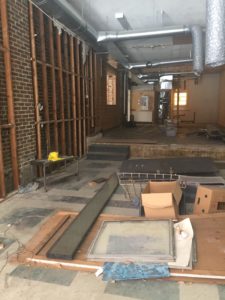Revitalization, Renovations, and Retrofits: What Do I Need to Know?
In a world where buildings are torn down and new ones take their places, and other areas where expansion brings about brand new structures, older spaces still gain a lot of attention. When it comes to rejuvenating an old space, there are many important considerations for revitalization and renovation projects. To answer some common questions people may have when it comes to this popular topic, we have compiled the knowledge and insight from our experts at Bilt: Jeff Gould (President), Travis Murphy (Construction Manager), and Muhammad Ali Hassan (Junior Project Manager).
What exactly is Revitalization and how is it different from Renovation or Retrofit?
Revitalization can be most simply defined as “bringing life back” to a building. Take for example abandoned, historic buildings or neighborhoods and the process in reconstructing them to breathe new life. This allows retention of history and sentimentality these buildings have in their areas.
Renovation focuses more on improving and often be considered as “modernizing” deteriorating elements. For example, dated dining rooms that look like their aesthetic is stuck in the 1980s. These renovations to update their appearance help in updating the look and feel for restaurants.
Retrofit involves the process of improving an existing building through means such as making it more energy efficient or strengthening structures to make them earthquake proof.
Before
After
What are some of the most common challenges when it comes to building revitalization projects?
For original structures, there are likely to be architectural standards by the city that need to be properly achieved for historic buildings. This can include maintaining the originality of the building as much as possible from what it once was such as original windows (the appearance, size, and shape), doors, roofing, and exterior siding. In Edmonton, we see many buildings in the downtown core reflective of their original state blended in with the more modern structures around them.
“Of course, we cannot get windows that were original and made from the 1800s. We look for custom window suppliers to recreate these windows. To make hardwood floors look like they are original, there are techniques such as heating and use of chemicals to create the effect on appearance as if they are worn or aged.” – Muhammad Ali Hassan, Junior Project Manager
In comprised structures, there are lot more to consider and inspect. From load bearing walls to deteriorating columns and structures (basically any structure that is holding up the building), these are major projects that need to be carefully examined and properly reconstructed in a safe manner.
“One way in going about replacing an exterior wall is to build frames to hold up the building while demolishing the deteriorated structure; while the frame is in place, a new, exterior is built and replicated as best as possible to its original appearance.” – Travis Murphy, Construction Manager
We have seen plumbing, wiring, and fixtures that are completely out of date; therefore, not up to code or have shown signs of tampering. Fixtures are almost always a common problem for buildings old and not as old. This is due to either improper initial installation, or someone less skilled had gone in and tried to “fix” these themselves. Animals are also commonly discovered in systems, walls, etc. It is not surprising that on occasion you will find dead animals lodged in nearly any space that they can fit into.
The Problem with Asbestos
Asbestos is possibly the biggest concern and challenge when it comes to safety along with the removal process. Asbestos was, and still sometimes used in other products today, used most as insulation and can be identified as soft, flexible fibers. Because asbestos is known for its reputation to be resistant to fire, heat, and chemicals along with its durability and flexibility, it was widely used and the go-to product when it came to insulation. For these older properties and the fact that asbestos could be supplied in mass, it was used in construction from as early as the 1800s and for nearly 100 years until more modern nations banned the use of them only a few decades ago.
Asbestos is particularly dangerous as it has been linked to harmful diseases including cancer (or mesothelioma to be specific) and other chronic lung diseases. Common cases of victims to asbestos exposure often include workers removing asbestos. During 9/11 and the destruction of the Twin Towers, toxic dust from asbestos had been one of the major causes of deaths and chronic diseases for victims that survived the immediate attack.
How Do You Handle Removal of Asbestos Safely?
“Personnel removing asbestos must have the proper training and certification. Removing asbestos cannot have shortcuts as safety is the biggest concern.” – Muhammad Ali Hassan, Junior Project Manager
There are key steps required to ensure a proper and safe process for removing asbestos. First, professionals will do visual inspections and take samples to determine the degree of the work. Proper PPE is also required for all personnel when in close proximation to asbestos removal. Fans are brought in and all windows and doors are opened to allow air circulation to blow toxic elements away from interiors. Waste is then carefully removed with safety protocols and cleaning crews are brought into provide final cleanups.
What are key considerations for new tenants or property owners to take when it comes to building revitalization?
“For costs, I would first suggest to them that they need to consider how long they plan to be there for and how much are they going to get out of it versus the costs put into this revitalization project” – Jeff Gould President
If tenants or owners plan to stay or operate there for the next 20 years, it is important to question whether they will get their investment’s worth when they exit. Revitalization projects can be costly, but their uniqueness is the prime appeal and selling points at the same time.
For the purpose of the building, it is important to know if it is to be used for residential, commercial, or industrial means. These purposes will need different approaches and planning that need to be taken into consideration because they will affect costs along with overall scope of the project.
As for location, along with the considerations of its purpose, the location of projects will need to be considered. We work with our clients, engineers, and architects to define the purpose of this project and create plans around its location of the project. Not only do we discuss the community and its potential, but we also assess the major aspect of safety during the construction. If the client’s business is planning to operate while we are delivering our project work, for example, we plan for the best possible scenario to how we can work doing it safely for everyone and not disrupting the business as well.




